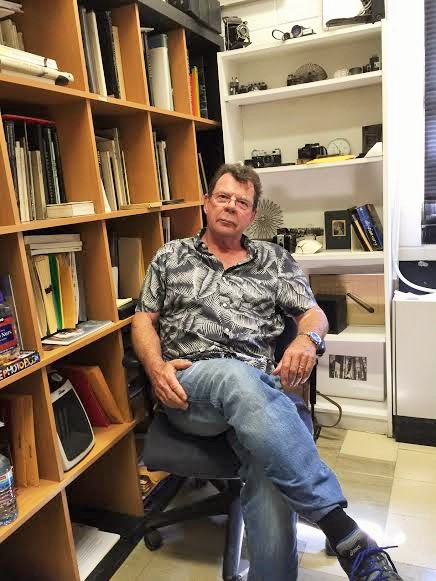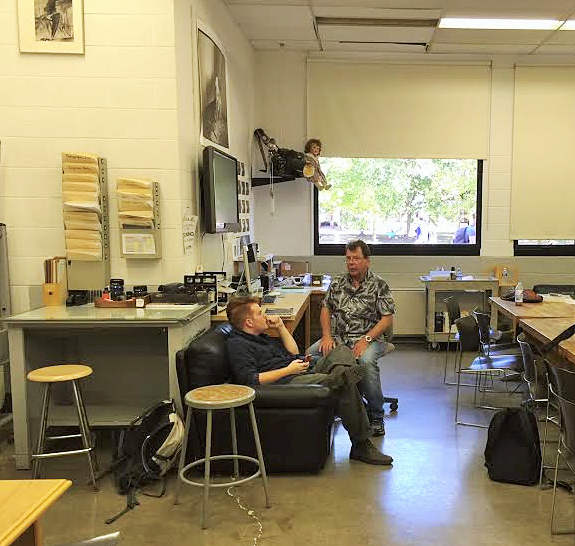The sound of jazz music and streams of light coming in from the lobby disappear when one walks through the narrow passageway of the makeshift darkroom in Calcia Hall. Inside, there is a long table in the center containing trays filled with fluids to develop photographs and a smaller room adjacent to the darkroom. “It’s working. Hooray!” said a man within the smaller room as he inspected an electric pump that was malfunctioning earlier that day.
The man is Klaus Schnitzer, 71, a professor at Montclair State University and the director of both the Photography program and the Minor in Art and Design. His stern face and fixed posture may hint at a strict character, but his demeanor is one of an individual who loves engaging with students about his craft. As the director of the Photography program, Schnitzer oversees all activities and issues with students and professors, such as checking up on equipment and acting as a mentor for students.
Although Schnitzer enjoys mentoring his students and working closely with them, the cramped space at Calcia Hall has become a concern for him and his students. For Schnitzer, the compact space of the photo lab is a clear indicator that more funding is needed for the Fine Arts department.
“A much bigger building will be essential for the Fine Arts department,” said Schnitzer as he looked around the studio that encompasses the wooded darkroom, “but by the time that happens, I’ll most likely be retired.”

Schnitzer, now 71 years old, will likely retire before Calcia Hall sees the improvements it sorely needs.
Photo Credit: Daniel Borja.
The darkroom is an example of how much more space is needed for the photography program. According to Schnitzer, the darkroom within the studio was created in 1975 as a temporary center for students, as its makeshift, narrow walls suggest that not much has changed since.
In the next two weeks, Schnitzer’s students from Photo I will get their first darkroom experience. The darkroom only has 10 enlargers – part of the equipment needed to produce photographs – but his class usually reaches a capacity of 16 students, which means that students initially have to pair up.
However, eventually students branch off into developing film or printing, an outcome that has worked as a solution for Schnitzer.
In addition, Schnitzer teaches Photo I, Photo III, Commercial Photography and 19th Century Photography. The last two courses are taught once a year and every few years, respectively.
These are only Schnitzer’s classes. This list doesn’t take into account other photography professors. Thus, every semester, the photo lab tends to be occupied.

Schnitzer’s students find it difficult to complete assignments with limited resources.
Photo Credit: Daniel Borja.
Some solutions to accommodate students in their use of the photo lab are provided through a sign-up list and 24-hour access for advanced students, which will include weekends as the semester progresses.
“There’s not enough hours in the week,” said Schnitzer, “so I have to add Saturdays and, towards the end of the semester, [the photo lab] is also open on Sundays.”
With weekend access available, the photo lab is still very hectic throughout the semester. Craig Peters, a sophomore, states that just waiting to use the enlarger is a frantic process.
As a first year lab assistant, Peters recalls tensions between students trying to use the photo lab. “Last semester, I remember there were 10 people on the list,” said Peters. “They were just sitting and waiting for other people to finish their projects.”
Still, Brianne Dougherty, a student in her last year, recalls some of the reasoning as to why it’s more frantic in the photo lab towards the end of the semester. “To be fair, people tend to leave their work to the last second and then everyone comes in here at the same time at the end of the semester,” said Dougherty.
Whether it’s helpful or problematic, to Schnitzer the temporary darkroom has overdone its purpose for over three decades. The incessant presence of students and tight space of the photo lab are signs that a bigger facility is needed for students of the Photography program, but also to accommodate all students majoring in Fine Arts.


